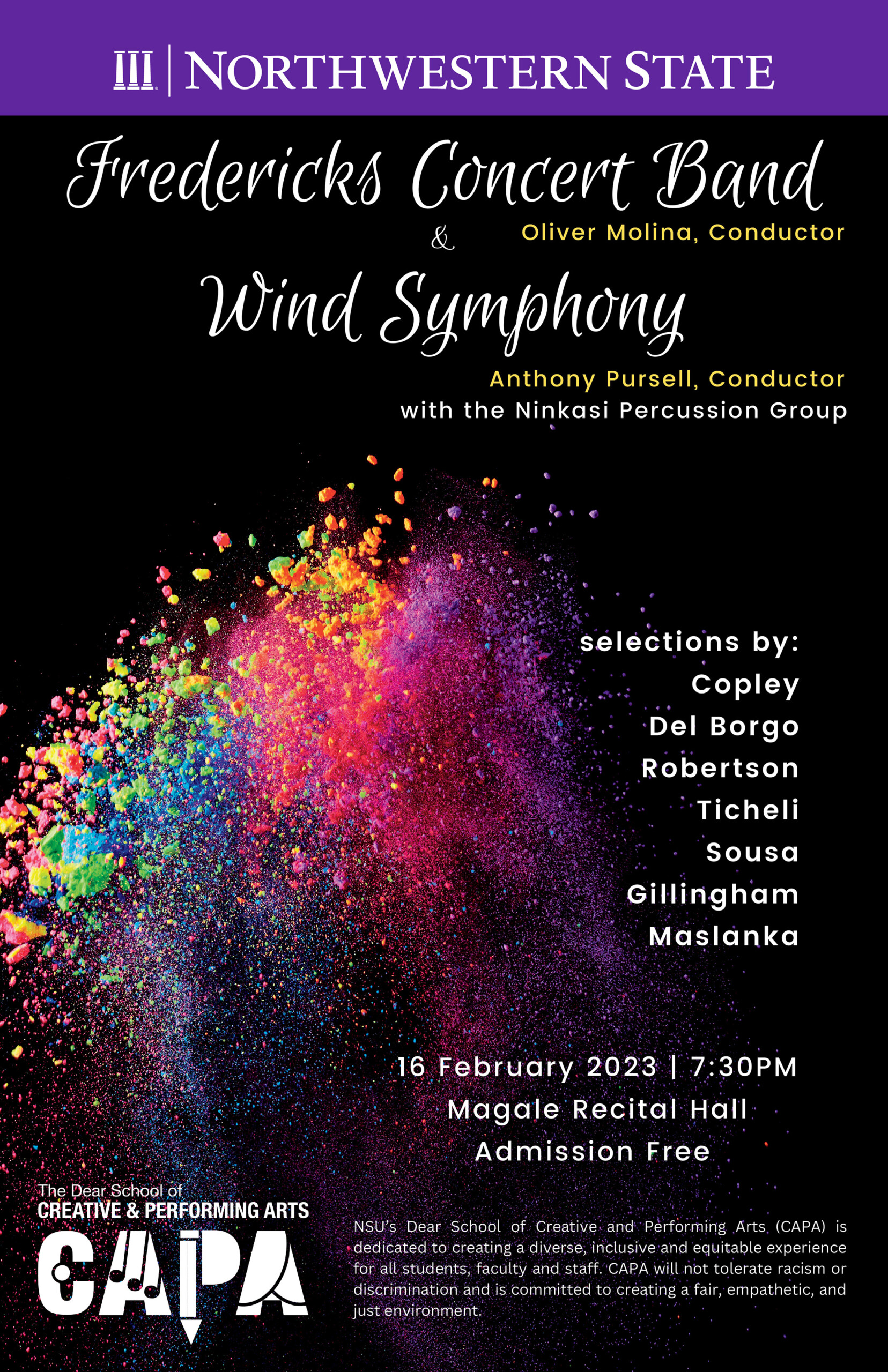NATCHITOCHES – The Northwestern State University Fredericks Concert Band and Wind Symphony will present its first concert of the spring 2023 semester on Thursday, February 16 at 7:30 p.m. in Magale Recital Hall. Admission is free and open to the public. A livestream link will be available at capa.nsula.edu/livestream.
The Fredericks Concert Band, conducted by Director of Percussion Studies and Assistant Director of Bands Dr. Oliver Molina, will present four works. Opening the concert is “Eureka” by Katahj Copley.
“Eureka, is a word used to express triumph on a discovery,” said Copley is describing their work. “Many of us have felt this feeling before. I’ve always wanted to write a piece about this, but I could never describe it in music form. Until finally (ironically) EUREKA! I figured out how with this short scherzo-like piece for the concert band. The beginning with the woodwinds and percussion represents the short burst of energy that lights the spark of curiosity. From there we build all the way to the next big moment of the melody. Finally, we reach the final exclamation- the final discovery that is a culmination of everything!”
Following this work, the Concert Band will perform “Abracadabra” by Frank Ticheli. The work simply demonstrates a playful, serious, innocent, and mischievous array of behaviors that one expects from children, who, in many regards, provide a large array of color in a short period of time.
The Concert Band will then perform “Leap!” By Karen Robertson. This work portrays the metaphorical leaps a person takes in life when taking chances with something new. The challenge of the work has the Fredericks Concert Band taking leaps of their own.
Concluding the Concert Band’s portion of the program is Elliott Del Borgo’s “Festa!,” an energetic and driving work that utilizes the power and color of the symphonic band in a contrasting three-part overture format. The dramatic opening dissolves to a slow, rhythmic pulse in the clarinets, under the melodic theme in the flutes. The low winds return with the theme and gradually add voices in very soft tones until an explosive return to the opening completes the work. Extensive use of percussion provides excitement and enhances the strong melodic material.
Following a brief intermission, the Northwestern State Wind Symphony, conducted by NSU’s Director of Bands Anthony Pursell, will take the stage to present three additional works for the audience. Beginning this part of the concert is an early march by John Philip Sousa, “Across the Danube.” Known for his iconic marches such as “Semper Fidelis,” “The Stars and Stripes Forever” and “The Washington Post,” this early march and its genesis can be traced to newspaper accounts of foreign wars. The Danube River was one of the borders between the Ottoman Empire and Czarist Russia. The two countries were regularly in conflict with one another, and in the fourth extended war, the Russians gained one decisive victory by crossing the Danube during the summer of 1877. Sousa credits the inspiration for “Across the Danube” to one such victory over the Turks.
The Wind Symphony will then present an exciting work by David Gillingham that will feature a percussion quartet, including Molina. The work explores many different emotions that will have the audience seeing many different colors to represent these contrasting moods.
Concluding the concert is David Maslanka’s “Symphony #4.” The work has many roots with some sources being geographical (Maslanka’s love of Montana), and others are literary (the clarinet “cries” in the symphony are to symbolize crying babies in Goethe’s “Faust”) and others are more subtle. Maslanka describes a desire for a “spontaneous need of the impulse to shout for the joy of life.” This is stated in the hymn tune “Old Hundred,” which, along with some chorales by J.S. Bach (including “Only Trust in God” and “Christ Who Makes Us Holy”) form the backbone for the symphony. If the use of hymn tunes is the structure of the work, the life of the piece is found in Maslanka’s longtime fascination with Abraham Lincoln and how his navigation in the struggle of opposites that was his life and death inspired his admirers today. Maslanka turned to accounts of people who knew Lincoln, including his friend David R. Locke, who describes Lincoln in death:
“I saw him, or what was mortal of him, in his coffin. The face had an expression of absolute content, or relief, at throwing off a burden such as few men have been called on to bear—a burden which few men could have borne. I have seen the same expression on his living face only a few times when after a great calamity he had come to great victory. It was the look of a worn man suddenly relieved. Wilkes Booth did Abraham Lincoln the greatest service man could possibly do for him—he gave him peace.”
The musical chaos that represents Lincoln is balanced by the sense of new life and hope symbolized by the “Doxology” (Old Hundredth), a praise to God using the mid-16th century setting of Psalm 100:
“Make a joyful noise unto the Lord, all ye lands. Serve the Lord with gladness: come before his presence with singing. Enter into his gates with thanksgiving and into his courts with praise: be thankful unto him and bless his name.”
While Maslanka uses Christian imagery, Pursell said the work is not specifically “Christian” in intent, however, as he showcases these ideas to achieve a depth of universal humanness that is not defined by a specific label.

